Accounting Theory & Contemporary Issues: SG Fleet Framework Analysis
VerifiedAdded on 2023/01/19
|10
|1916
|86
Report
AI Summary
This report provides an executive summary analyzing SG Fleet Limited's compliance with the conceptual framework (CF) of accounting, focusing on the qualitative characteristics and other criteria outlined by the Australian Accounting Standards Board (AASB). The report examines the implementation of measurement requirements, fundamental and enhancing qualitative characteristics (relevance, faithful presentation, understandability, comparability, timeliness, and verifiability), and the usefulness of financial reports in decision-making. It highlights how SG Fleet integrates historical and fair value measurements, ensuring its financial reports are of high quality and useful for end-users. The analysis also considers the knowledge required by end-users to analyze financial reports and the requirements for general-purpose financial reporting, concluding that SG Fleet's financial information is reliable and supports informed investment decisions. The report recommends that investors find the information trustworthy for making investment decisions.
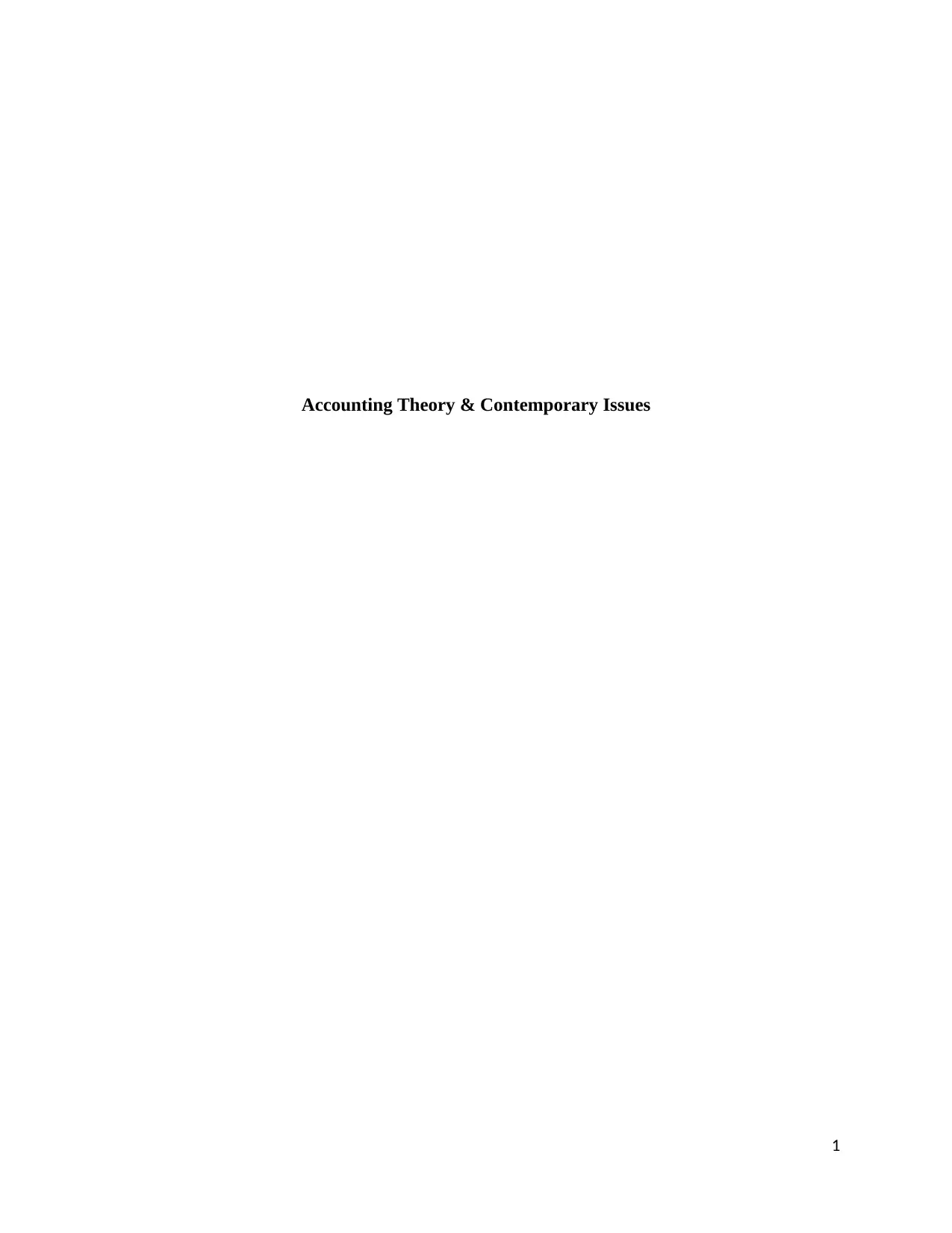
Accounting Theory & Contemporary Issues
1
1
Paraphrase This Document
Need a fresh take? Get an instant paraphrase of this document with our AI Paraphraser
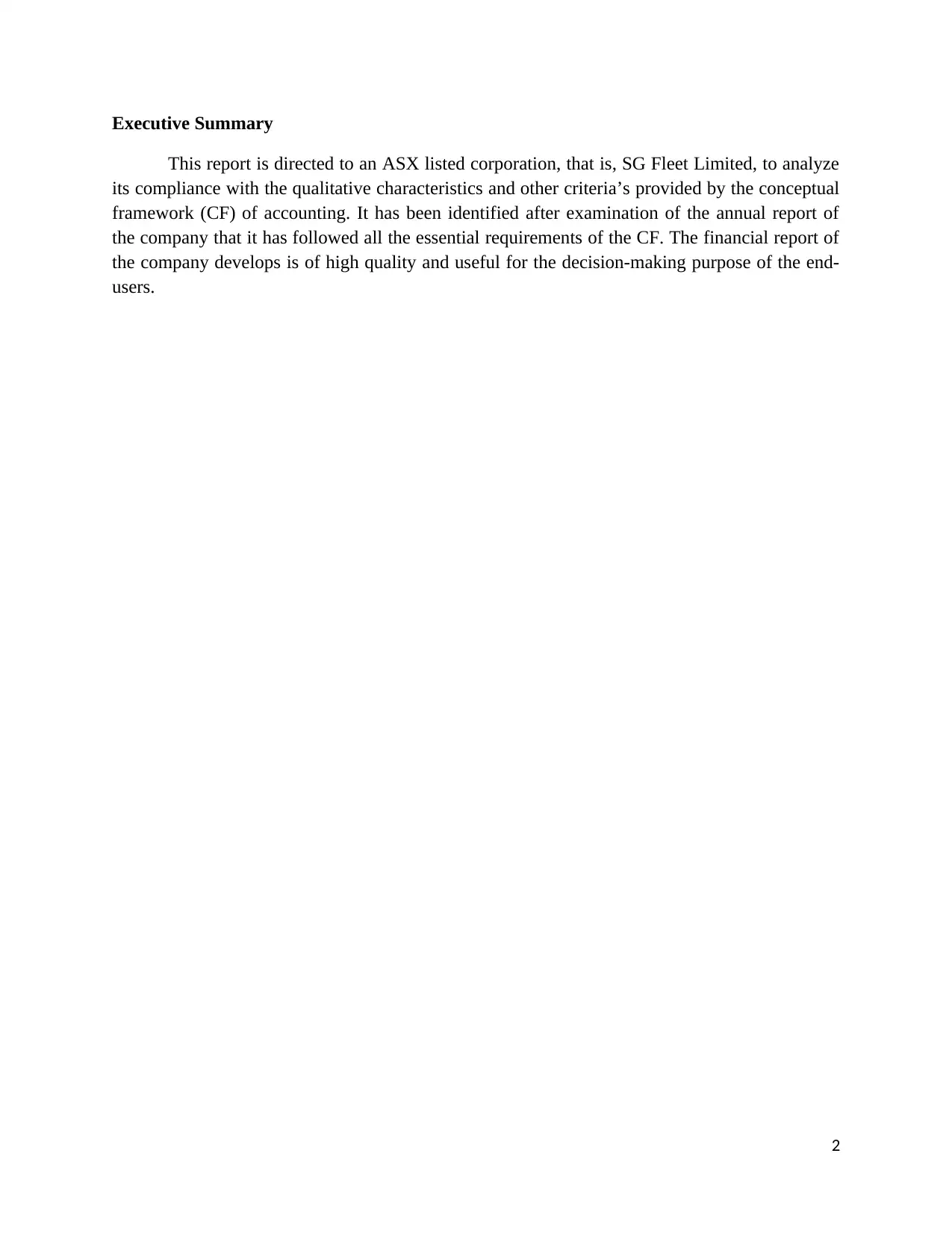
Executive Summary
This report is directed to an ASX listed corporation, that is, SG Fleet Limited, to analyze
its compliance with the qualitative characteristics and other criteria’s provided by the conceptual
framework (CF) of accounting. It has been identified after examination of the annual report of
the company that it has followed all the essential requirements of the CF. The financial report of
the company develops is of high quality and useful for the decision-making purpose of the end-
users.
2
This report is directed to an ASX listed corporation, that is, SG Fleet Limited, to analyze
its compliance with the qualitative characteristics and other criteria’s provided by the conceptual
framework (CF) of accounting. It has been identified after examination of the annual report of
the company that it has followed all the essential requirements of the CF. The financial report of
the company develops is of high quality and useful for the decision-making purpose of the end-
users.
2
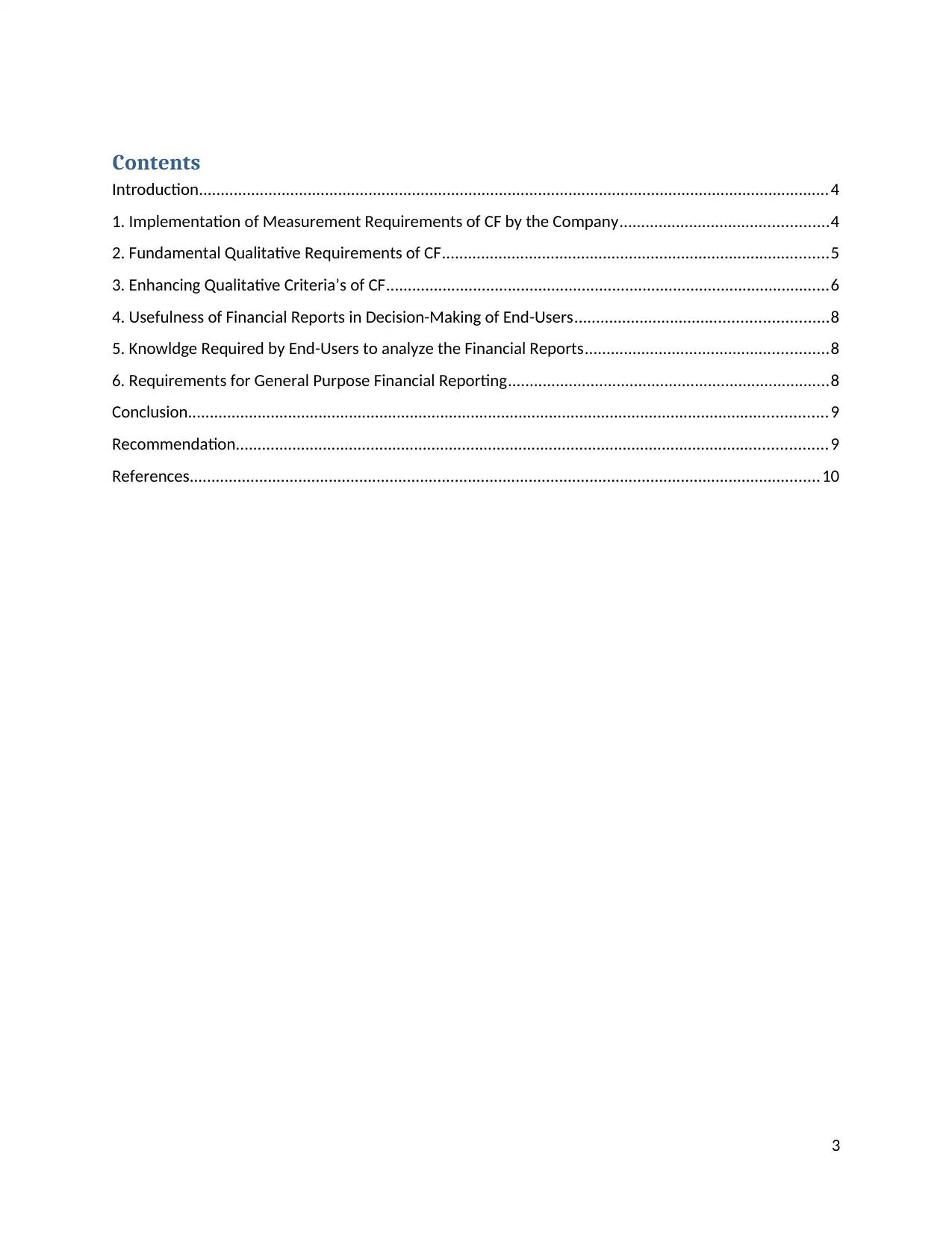
Contents
Introduction.................................................................................................................................................4
1. Implementation of Measurement Requirements of CF by the Company................................................4
2. Fundamental Qualitative Requirements of CF.........................................................................................5
3. Enhancing Qualitative Criteria’s of CF......................................................................................................6
4. Usefulness of Financial Reports in Decision-Making of End-Users..........................................................8
5. Knowldge Required by End-Users to analyze the Financial Reports........................................................8
6. Requirements for General Purpose Financial Reporting..........................................................................8
Conclusion...................................................................................................................................................9
Recommendation........................................................................................................................................9
References.................................................................................................................................................10
3
Introduction.................................................................................................................................................4
1. Implementation of Measurement Requirements of CF by the Company................................................4
2. Fundamental Qualitative Requirements of CF.........................................................................................5
3. Enhancing Qualitative Criteria’s of CF......................................................................................................6
4. Usefulness of Financial Reports in Decision-Making of End-Users..........................................................8
5. Knowldge Required by End-Users to analyze the Financial Reports........................................................8
6. Requirements for General Purpose Financial Reporting..........................................................................8
Conclusion...................................................................................................................................................9
Recommendation........................................................................................................................................9
References.................................................................................................................................................10
3
⊘ This is a preview!⊘
Do you want full access?
Subscribe today to unlock all pages.

Trusted by 1+ million students worldwide
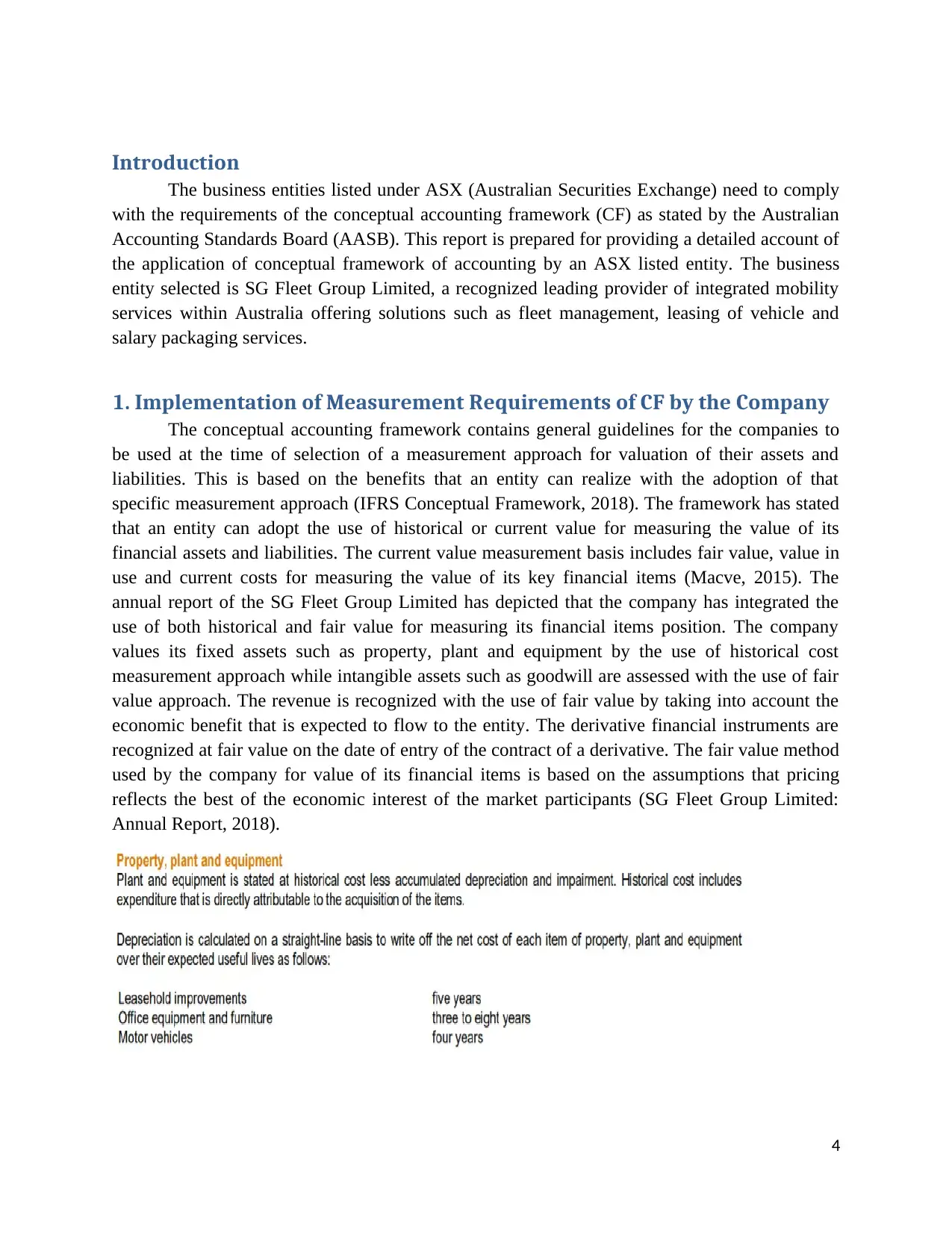
Introduction
The business entities listed under ASX (Australian Securities Exchange) need to comply
with the requirements of the conceptual accounting framework (CF) as stated by the Australian
Accounting Standards Board (AASB). This report is prepared for providing a detailed account of
the application of conceptual framework of accounting by an ASX listed entity. The business
entity selected is SG Fleet Group Limited, a recognized leading provider of integrated mobility
services within Australia offering solutions such as fleet management, leasing of vehicle and
salary packaging services.
1. Implementation of Measurement Requirements of CF by the Company
The conceptual accounting framework contains general guidelines for the companies to
be used at the time of selection of a measurement approach for valuation of their assets and
liabilities. This is based on the benefits that an entity can realize with the adoption of that
specific measurement approach (IFRS Conceptual Framework, 2018). The framework has stated
that an entity can adopt the use of historical or current value for measuring the value of its
financial assets and liabilities. The current value measurement basis includes fair value, value in
use and current costs for measuring the value of its key financial items (Macve, 2015). The
annual report of the SG Fleet Group Limited has depicted that the company has integrated the
use of both historical and fair value for measuring its financial items position. The company
values its fixed assets such as property, plant and equipment by the use of historical cost
measurement approach while intangible assets such as goodwill are assessed with the use of fair
value approach. The revenue is recognized with the use of fair value by taking into account the
economic benefit that is expected to flow to the entity. The derivative financial instruments are
recognized at fair value on the date of entry of the contract of a derivative. The fair value method
used by the company for value of its financial items is based on the assumptions that pricing
reflects the best of the economic interest of the market participants (SG Fleet Group Limited:
Annual Report, 2018).
4
The business entities listed under ASX (Australian Securities Exchange) need to comply
with the requirements of the conceptual accounting framework (CF) as stated by the Australian
Accounting Standards Board (AASB). This report is prepared for providing a detailed account of
the application of conceptual framework of accounting by an ASX listed entity. The business
entity selected is SG Fleet Group Limited, a recognized leading provider of integrated mobility
services within Australia offering solutions such as fleet management, leasing of vehicle and
salary packaging services.
1. Implementation of Measurement Requirements of CF by the Company
The conceptual accounting framework contains general guidelines for the companies to
be used at the time of selection of a measurement approach for valuation of their assets and
liabilities. This is based on the benefits that an entity can realize with the adoption of that
specific measurement approach (IFRS Conceptual Framework, 2018). The framework has stated
that an entity can adopt the use of historical or current value for measuring the value of its
financial assets and liabilities. The current value measurement basis includes fair value, value in
use and current costs for measuring the value of its key financial items (Macve, 2015). The
annual report of the SG Fleet Group Limited has depicted that the company has integrated the
use of both historical and fair value for measuring its financial items position. The company
values its fixed assets such as property, plant and equipment by the use of historical cost
measurement approach while intangible assets such as goodwill are assessed with the use of fair
value approach. The revenue is recognized with the use of fair value by taking into account the
economic benefit that is expected to flow to the entity. The derivative financial instruments are
recognized at fair value on the date of entry of the contract of a derivative. The fair value method
used by the company for value of its financial items is based on the assumptions that pricing
reflects the best of the economic interest of the market participants (SG Fleet Group Limited:
Annual Report, 2018).
4
Paraphrase This Document
Need a fresh take? Get an instant paraphrase of this document with our AI Paraphraser
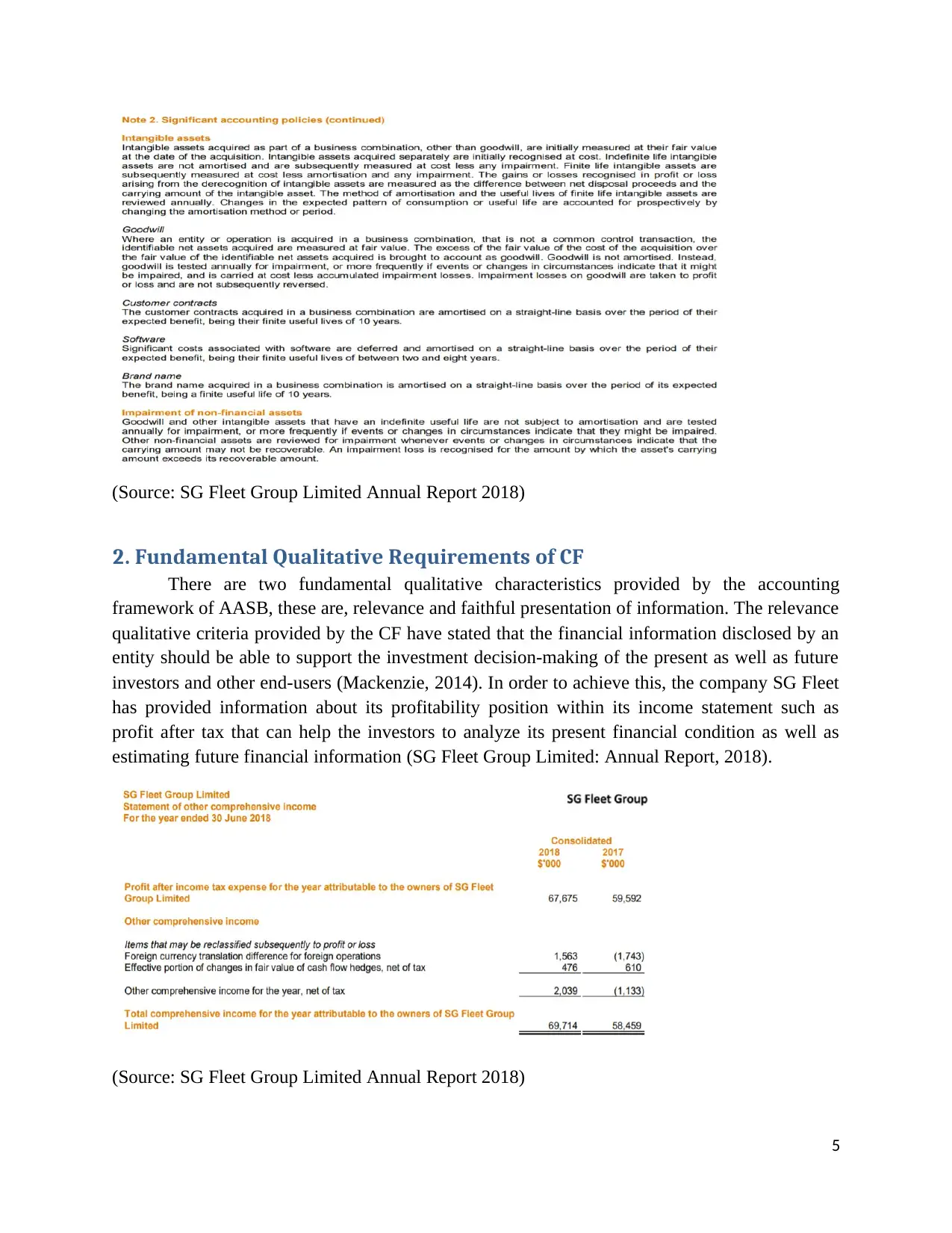
(Source: SG Fleet Group Limited Annual Report 2018)
2. Fundamental Qualitative Requirements of CF
There are two fundamental qualitative characteristics provided by the accounting
framework of AASB, these are, relevance and faithful presentation of information. The relevance
qualitative criteria provided by the CF have stated that the financial information disclosed by an
entity should be able to support the investment decision-making of the present as well as future
investors and other end-users (Mackenzie, 2014). In order to achieve this, the company SG Fleet
has provided information about its profitability position within its income statement such as
profit after tax that can help the investors to analyze its present financial condition as well as
estimating future financial information (SG Fleet Group Limited: Annual Report, 2018).
(Source: SG Fleet Group Limited Annual Report 2018)
5
2. Fundamental Qualitative Requirements of CF
There are two fundamental qualitative characteristics provided by the accounting
framework of AASB, these are, relevance and faithful presentation of information. The relevance
qualitative criteria provided by the CF have stated that the financial information disclosed by an
entity should be able to support the investment decision-making of the present as well as future
investors and other end-users (Mackenzie, 2014). In order to achieve this, the company SG Fleet
has provided information about its profitability position within its income statement such as
profit after tax that can help the investors to analyze its present financial condition as well as
estimating future financial information (SG Fleet Group Limited: Annual Report, 2018).
(Source: SG Fleet Group Limited Annual Report 2018)
5
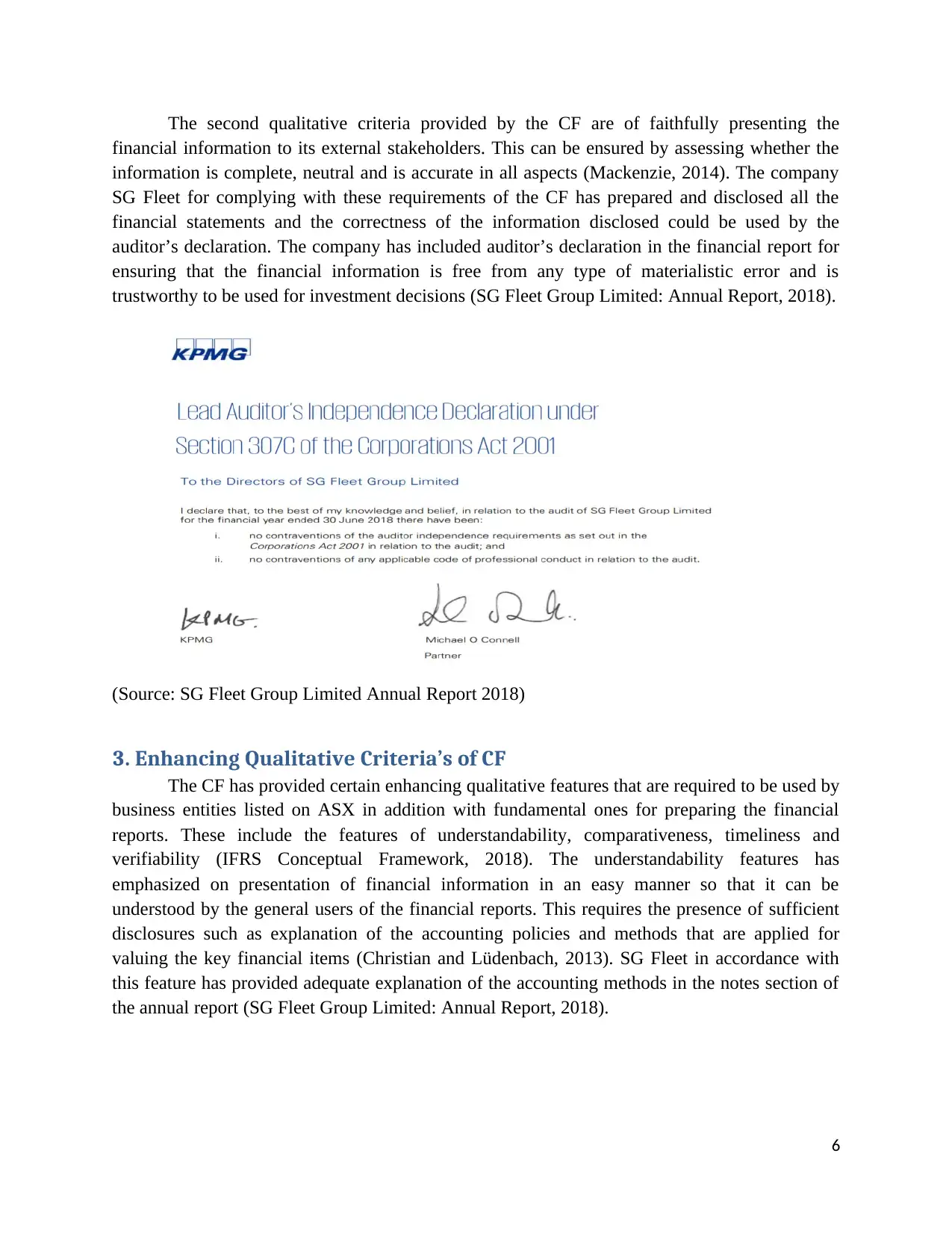
The second qualitative criteria provided by the CF are of faithfully presenting the
financial information to its external stakeholders. This can be ensured by assessing whether the
information is complete, neutral and is accurate in all aspects (Mackenzie, 2014). The company
SG Fleet for complying with these requirements of the CF has prepared and disclosed all the
financial statements and the correctness of the information disclosed could be used by the
auditor’s declaration. The company has included auditor’s declaration in the financial report for
ensuring that the financial information is free from any type of materialistic error and is
trustworthy to be used for investment decisions (SG Fleet Group Limited: Annual Report, 2018).
(Source: SG Fleet Group Limited Annual Report 2018)
3. Enhancing Qualitative Criteria’s of CF
The CF has provided certain enhancing qualitative features that are required to be used by
business entities listed on ASX in addition with fundamental ones for preparing the financial
reports. These include the features of understandability, comparativeness, timeliness and
verifiability (IFRS Conceptual Framework, 2018). The understandability features has
emphasized on presentation of financial information in an easy manner so that it can be
understood by the general users of the financial reports. This requires the presence of sufficient
disclosures such as explanation of the accounting policies and methods that are applied for
valuing the key financial items (Christian and Lüdenbach, 2013). SG Fleet in accordance with
this feature has provided adequate explanation of the accounting methods in the notes section of
the annual report (SG Fleet Group Limited: Annual Report, 2018).
6
financial information to its external stakeholders. This can be ensured by assessing whether the
information is complete, neutral and is accurate in all aspects (Mackenzie, 2014). The company
SG Fleet for complying with these requirements of the CF has prepared and disclosed all the
financial statements and the correctness of the information disclosed could be used by the
auditor’s declaration. The company has included auditor’s declaration in the financial report for
ensuring that the financial information is free from any type of materialistic error and is
trustworthy to be used for investment decisions (SG Fleet Group Limited: Annual Report, 2018).
(Source: SG Fleet Group Limited Annual Report 2018)
3. Enhancing Qualitative Criteria’s of CF
The CF has provided certain enhancing qualitative features that are required to be used by
business entities listed on ASX in addition with fundamental ones for preparing the financial
reports. These include the features of understandability, comparativeness, timeliness and
verifiability (IFRS Conceptual Framework, 2018). The understandability features has
emphasized on presentation of financial information in an easy manner so that it can be
understood by the general users of the financial reports. This requires the presence of sufficient
disclosures such as explanation of the accounting policies and methods that are applied for
valuing the key financial items (Christian and Lüdenbach, 2013). SG Fleet in accordance with
this feature has provided adequate explanation of the accounting methods in the notes section of
the annual report (SG Fleet Group Limited: Annual Report, 2018).
6
⊘ This is a preview!⊘
Do you want full access?
Subscribe today to unlock all pages.

Trusted by 1+ million students worldwide
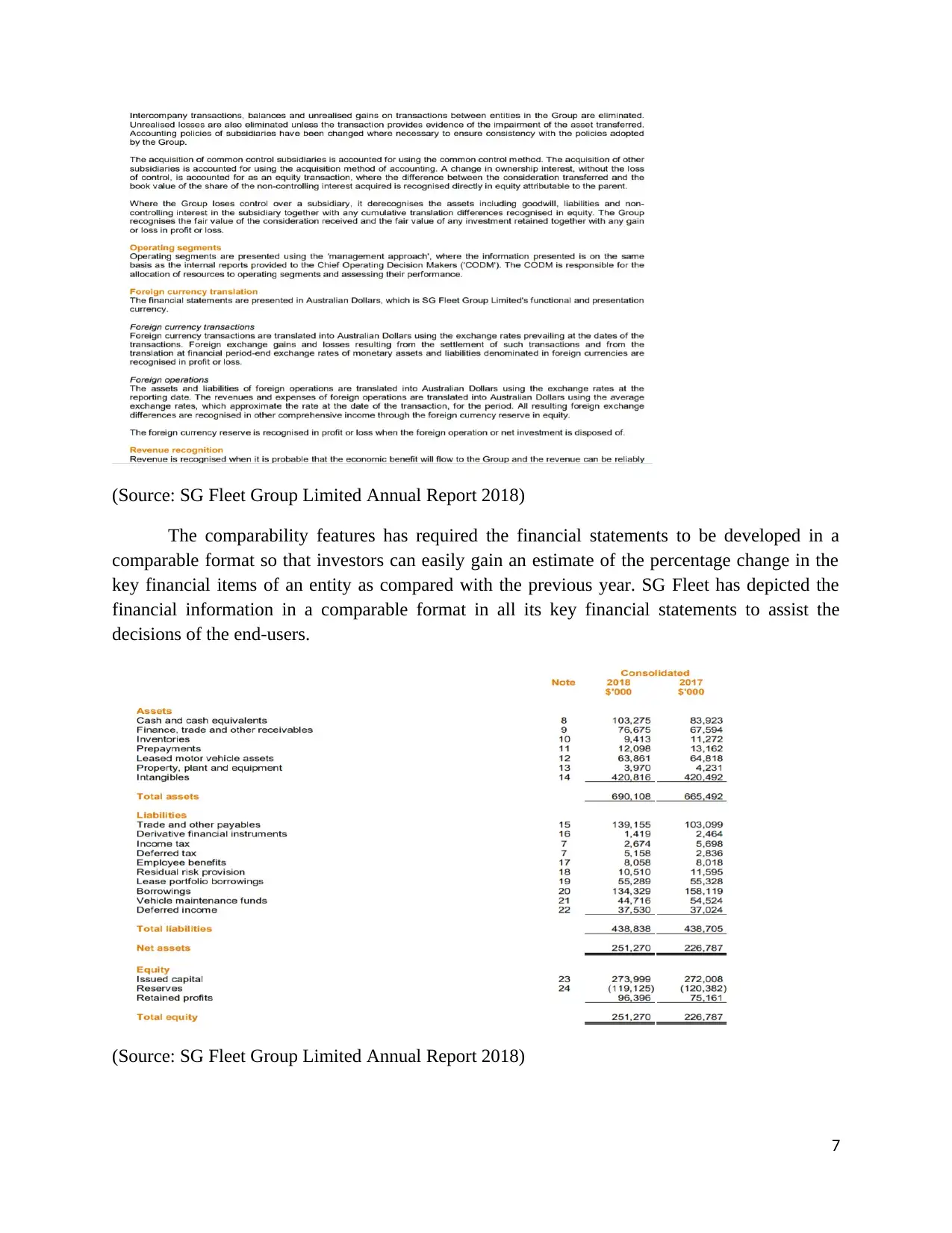
(Source: SG Fleet Group Limited Annual Report 2018)
The comparability features has required the financial statements to be developed in a
comparable format so that investors can easily gain an estimate of the percentage change in the
key financial items of an entity as compared with the previous year. SG Fleet has depicted the
financial information in a comparable format in all its key financial statements to assist the
decisions of the end-users.
(Source: SG Fleet Group Limited Annual Report 2018)
7
The comparability features has required the financial statements to be developed in a
comparable format so that investors can easily gain an estimate of the percentage change in the
key financial items of an entity as compared with the previous year. SG Fleet has depicted the
financial information in a comparable format in all its key financial statements to assist the
decisions of the end-users.
(Source: SG Fleet Group Limited Annual Report 2018)
7
Paraphrase This Document
Need a fresh take? Get an instant paraphrase of this document with our AI Paraphraser
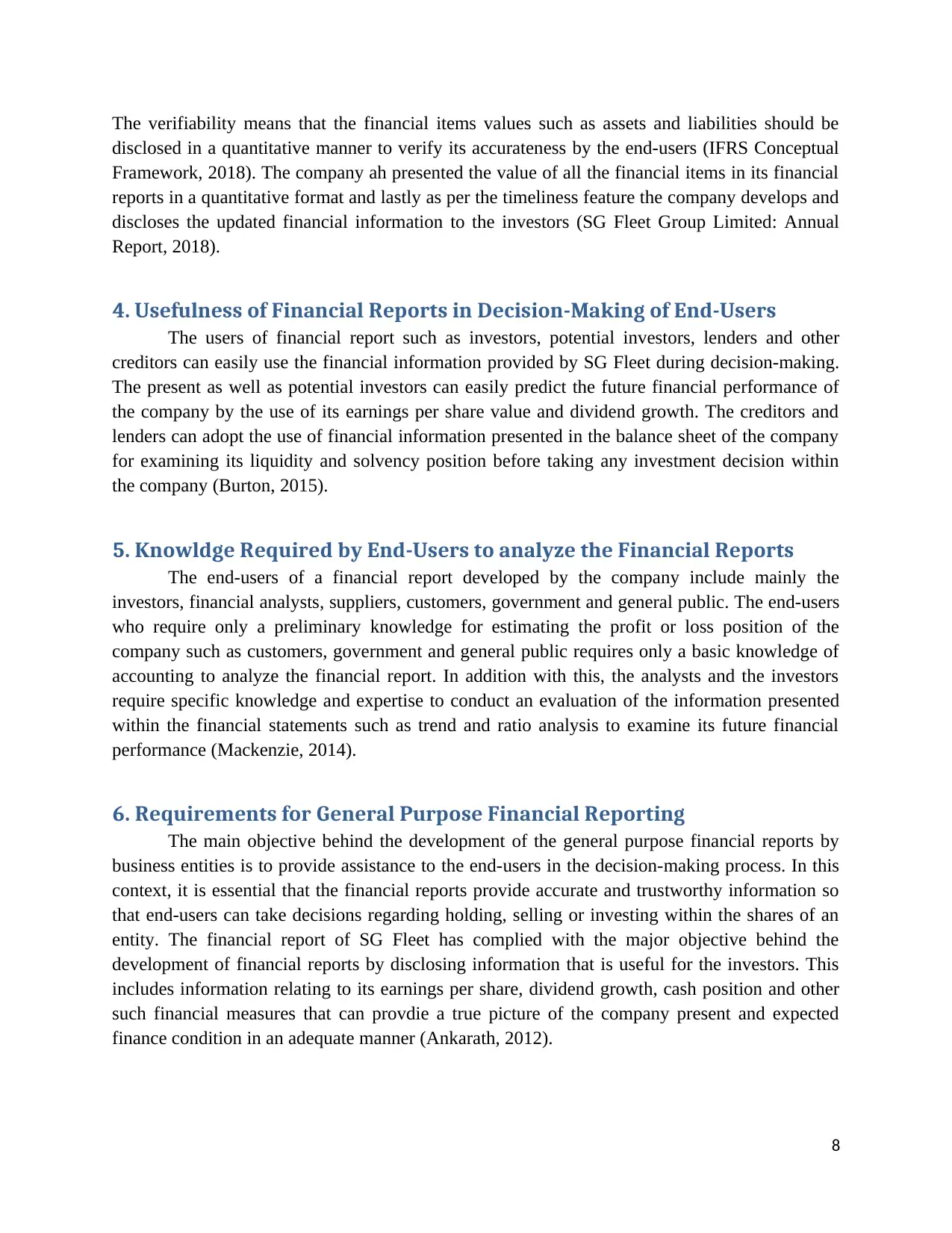
The verifiability means that the financial items values such as assets and liabilities should be
disclosed in a quantitative manner to verify its accurateness by the end-users (IFRS Conceptual
Framework, 2018). The company ah presented the value of all the financial items in its financial
reports in a quantitative format and lastly as per the timeliness feature the company develops and
discloses the updated financial information to the investors (SG Fleet Group Limited: Annual
Report, 2018).
4. Usefulness of Financial Reports in Decision-Making of End-Users
The users of financial report such as investors, potential investors, lenders and other
creditors can easily use the financial information provided by SG Fleet during decision-making.
The present as well as potential investors can easily predict the future financial performance of
the company by the use of its earnings per share value and dividend growth. The creditors and
lenders can adopt the use of financial information presented in the balance sheet of the company
for examining its liquidity and solvency position before taking any investment decision within
the company (Burton, 2015).
5. Knowldge Required by End-Users to analyze the Financial Reports
The end-users of a financial report developed by the company include mainly the
investors, financial analysts, suppliers, customers, government and general public. The end-users
who require only a preliminary knowledge for estimating the profit or loss position of the
company such as customers, government and general public requires only a basic knowledge of
accounting to analyze the financial report. In addition with this, the analysts and the investors
require specific knowledge and expertise to conduct an evaluation of the information presented
within the financial statements such as trend and ratio analysis to examine its future financial
performance (Mackenzie, 2014).
6. Requirements for General Purpose Financial Reporting
The main objective behind the development of the general purpose financial reports by
business entities is to provide assistance to the end-users in the decision-making process. In this
context, it is essential that the financial reports provide accurate and trustworthy information so
that end-users can take decisions regarding holding, selling or investing within the shares of an
entity. The financial report of SG Fleet has complied with the major objective behind the
development of financial reports by disclosing information that is useful for the investors. This
includes information relating to its earnings per share, dividend growth, cash position and other
such financial measures that can provdie a true picture of the company present and expected
finance condition in an adequate manner (Ankarath, 2012).
8
disclosed in a quantitative manner to verify its accurateness by the end-users (IFRS Conceptual
Framework, 2018). The company ah presented the value of all the financial items in its financial
reports in a quantitative format and lastly as per the timeliness feature the company develops and
discloses the updated financial information to the investors (SG Fleet Group Limited: Annual
Report, 2018).
4. Usefulness of Financial Reports in Decision-Making of End-Users
The users of financial report such as investors, potential investors, lenders and other
creditors can easily use the financial information provided by SG Fleet during decision-making.
The present as well as potential investors can easily predict the future financial performance of
the company by the use of its earnings per share value and dividend growth. The creditors and
lenders can adopt the use of financial information presented in the balance sheet of the company
for examining its liquidity and solvency position before taking any investment decision within
the company (Burton, 2015).
5. Knowldge Required by End-Users to analyze the Financial Reports
The end-users of a financial report developed by the company include mainly the
investors, financial analysts, suppliers, customers, government and general public. The end-users
who require only a preliminary knowledge for estimating the profit or loss position of the
company such as customers, government and general public requires only a basic knowledge of
accounting to analyze the financial report. In addition with this, the analysts and the investors
require specific knowledge and expertise to conduct an evaluation of the information presented
within the financial statements such as trend and ratio analysis to examine its future financial
performance (Mackenzie, 2014).
6. Requirements for General Purpose Financial Reporting
The main objective behind the development of the general purpose financial reports by
business entities is to provide assistance to the end-users in the decision-making process. In this
context, it is essential that the financial reports provide accurate and trustworthy information so
that end-users can take decisions regarding holding, selling or investing within the shares of an
entity. The financial report of SG Fleet has complied with the major objective behind the
development of financial reports by disclosing information that is useful for the investors. This
includes information relating to its earnings per share, dividend growth, cash position and other
such financial measures that can provdie a true picture of the company present and expected
finance condition in an adequate manner (Ankarath, 2012).
8
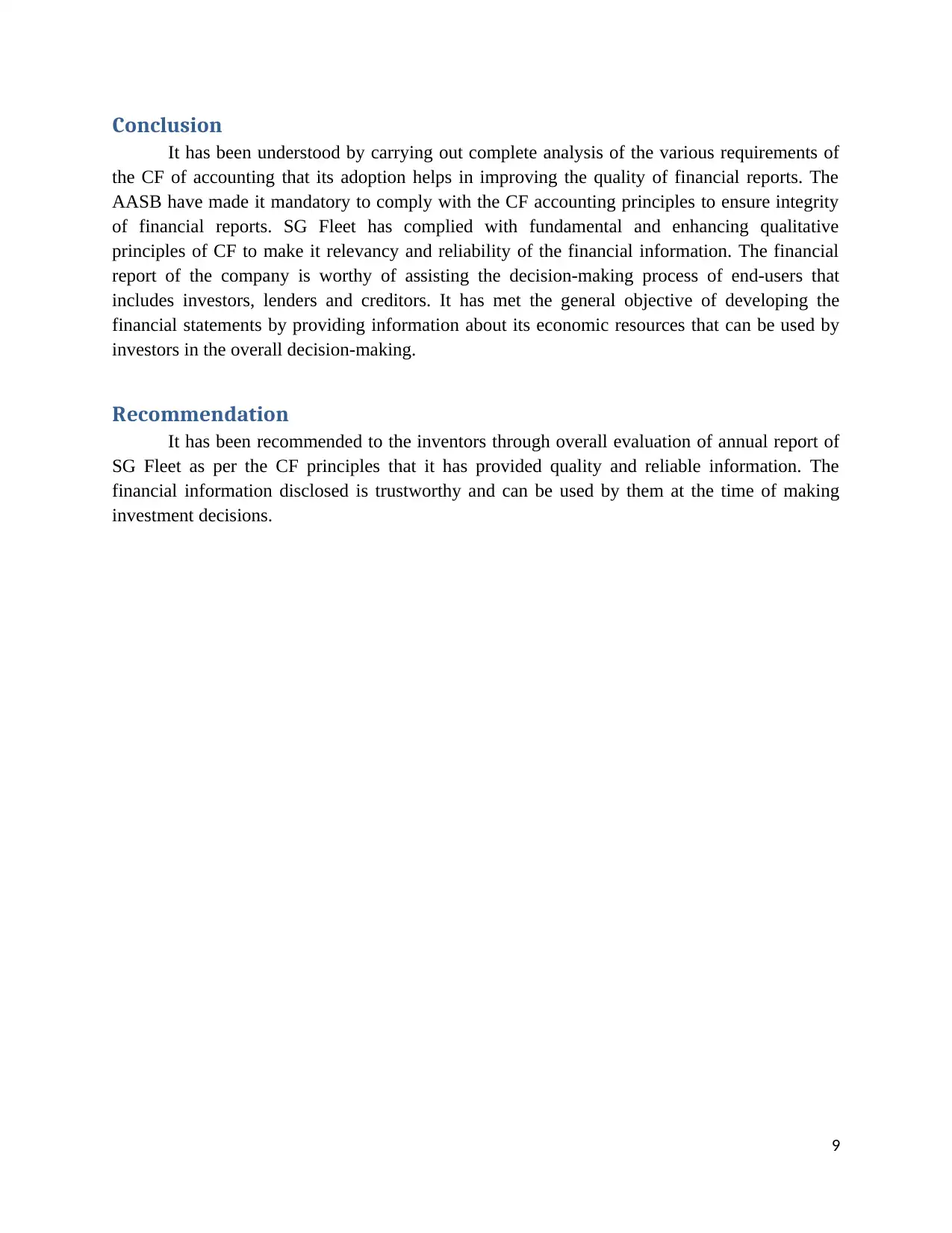
Conclusion
It has been understood by carrying out complete analysis of the various requirements of
the CF of accounting that its adoption helps in improving the quality of financial reports. The
AASB have made it mandatory to comply with the CF accounting principles to ensure integrity
of financial reports. SG Fleet has complied with fundamental and enhancing qualitative
principles of CF to make it relevancy and reliability of the financial information. The financial
report of the company is worthy of assisting the decision-making process of end-users that
includes investors, lenders and creditors. It has met the general objective of developing the
financial statements by providing information about its economic resources that can be used by
investors in the overall decision-making.
Recommendation
It has been recommended to the inventors through overall evaluation of annual report of
SG Fleet as per the CF principles that it has provided quality and reliable information. The
financial information disclosed is trustworthy and can be used by them at the time of making
investment decisions.
9
It has been understood by carrying out complete analysis of the various requirements of
the CF of accounting that its adoption helps in improving the quality of financial reports. The
AASB have made it mandatory to comply with the CF accounting principles to ensure integrity
of financial reports. SG Fleet has complied with fundamental and enhancing qualitative
principles of CF to make it relevancy and reliability of the financial information. The financial
report of the company is worthy of assisting the decision-making process of end-users that
includes investors, lenders and creditors. It has met the general objective of developing the
financial statements by providing information about its economic resources that can be used by
investors in the overall decision-making.
Recommendation
It has been recommended to the inventors through overall evaluation of annual report of
SG Fleet as per the CF principles that it has provided quality and reliable information. The
financial information disclosed is trustworthy and can be used by them at the time of making
investment decisions.
9
⊘ This is a preview!⊘
Do you want full access?
Subscribe today to unlock all pages.

Trusted by 1+ million students worldwide
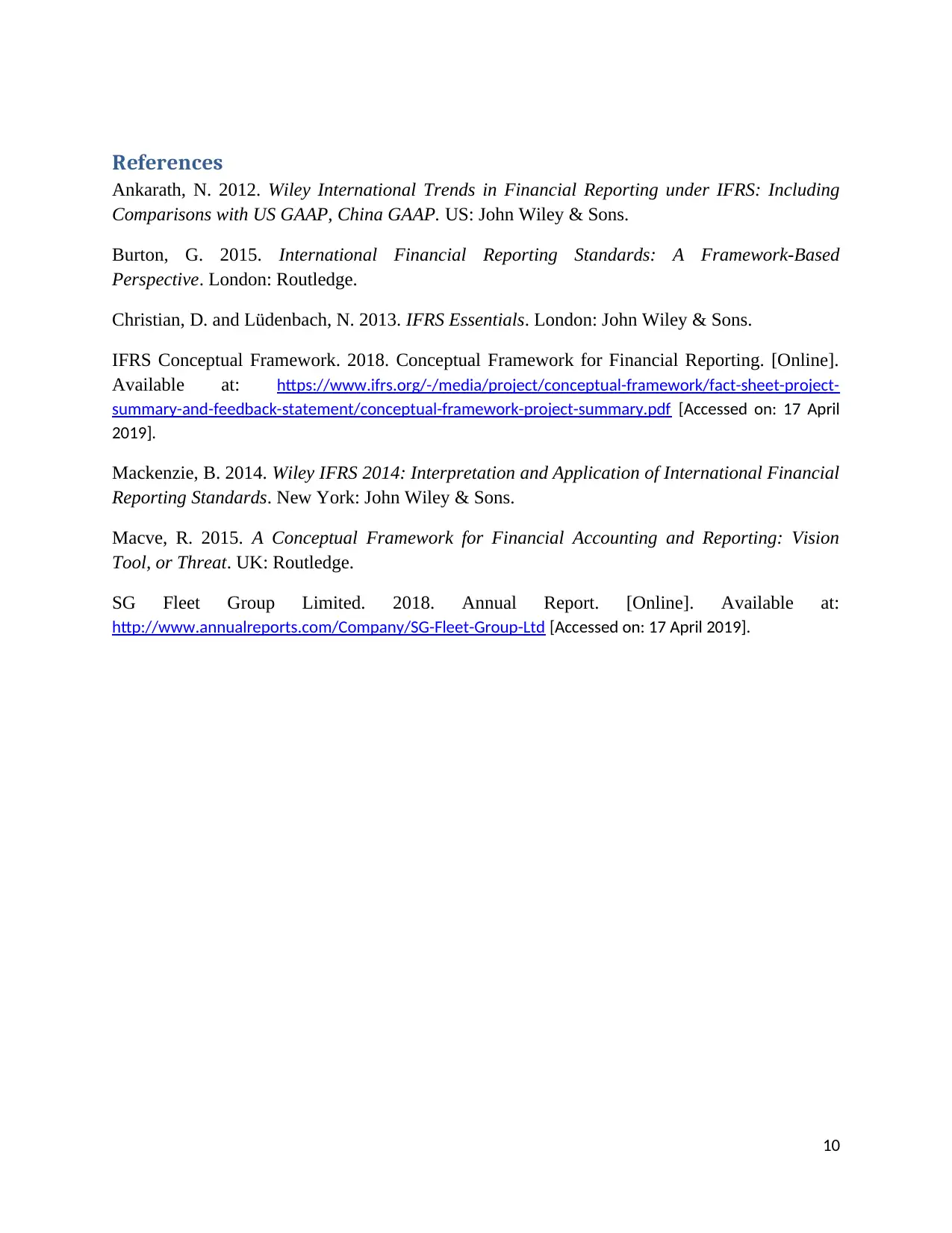
References
Ankarath, N. 2012. Wiley International Trends in Financial Reporting under IFRS: Including
Comparisons with US GAAP, China GAAP. US: John Wiley & Sons.
Burton, G. 2015. International Financial Reporting Standards: A Framework-Based
Perspective. London: Routledge.
Christian, D. and Lüdenbach, N. 2013. IFRS Essentials. London: John Wiley & Sons.
IFRS Conceptual Framework. 2018. Conceptual Framework for Financial Reporting. [Online].
Available at: https://www.ifrs.org/-/media/project/conceptual-framework/fact-sheet-project-
summary-and-feedback-statement/conceptual-framework-project-summary.pdf [Accessed on: 17 April
2019].
Mackenzie, B. 2014. Wiley IFRS 2014: Interpretation and Application of International Financial
Reporting Standards. New York: John Wiley & Sons.
Macve, R. 2015. A Conceptual Framework for Financial Accounting and Reporting: Vision
Tool, or Threat. UK: Routledge.
SG Fleet Group Limited. 2018. Annual Report. [Online]. Available at:
http://www.annualreports.com/Company/SG-Fleet-Group-Ltd [Accessed on: 17 April 2019].
10
Ankarath, N. 2012. Wiley International Trends in Financial Reporting under IFRS: Including
Comparisons with US GAAP, China GAAP. US: John Wiley & Sons.
Burton, G. 2015. International Financial Reporting Standards: A Framework-Based
Perspective. London: Routledge.
Christian, D. and Lüdenbach, N. 2013. IFRS Essentials. London: John Wiley & Sons.
IFRS Conceptual Framework. 2018. Conceptual Framework for Financial Reporting. [Online].
Available at: https://www.ifrs.org/-/media/project/conceptual-framework/fact-sheet-project-
summary-and-feedback-statement/conceptual-framework-project-summary.pdf [Accessed on: 17 April
2019].
Mackenzie, B. 2014. Wiley IFRS 2014: Interpretation and Application of International Financial
Reporting Standards. New York: John Wiley & Sons.
Macve, R. 2015. A Conceptual Framework for Financial Accounting and Reporting: Vision
Tool, or Threat. UK: Routledge.
SG Fleet Group Limited. 2018. Annual Report. [Online]. Available at:
http://www.annualreports.com/Company/SG-Fleet-Group-Ltd [Accessed on: 17 April 2019].
10
1 out of 10
Related Documents
Your All-in-One AI-Powered Toolkit for Academic Success.
+13062052269
info@desklib.com
Available 24*7 on WhatsApp / Email
![[object Object]](/_next/static/media/star-bottom.7253800d.svg)
Unlock your academic potential
Copyright © 2020–2025 A2Z Services. All Rights Reserved. Developed and managed by ZUCOL.





